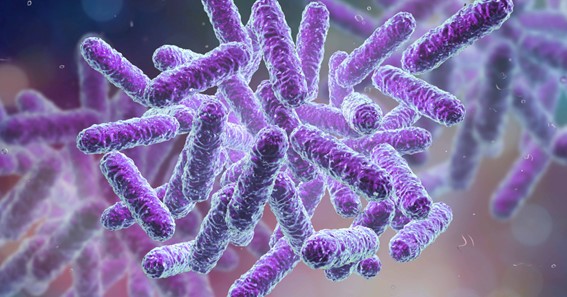Let’s say you wake up one morning and feel a little off. You’re tired, your muscles and joints hurt, your throat is dry and sore, and you have a runny nose.
At this point, it’s probably safe to assume that you’ve caught some kind of bug. But, is it a viral or bacterial infection? And speaking of, what’s the difference between bacteria and viruses, anyway?
That’s precisely what we’re here to explore.
What are bacteria?
According to Merriam-Webster, a bacterium (singular for bacteria) is “any of a domain of chiefly round, spiral, or rod-shaped single-celled prokaryotic microorganisms that typically live in soil, water, organic matter, or the bodies of plants and animals, that make their own food, especially from sunlight or are saprophytic or parasitic, are often motile by means of flagella, reproduce especially by binary fission, and include many important pathogens”.
Simply put, bacteria are living organisms usually made up of a single cell. We’re surrounded by thousands of bacteria every day. In fact, bacteria make up about 15% of the total mass of organisms on the entire planet, while humans make up just 0.01% of the total mass — wow!
While that might sound scary, it’s actually quite the opposite. Most bacteria are actually very useful to humans. Our bodies carry millions of bacteria, mostly in the gut and on the skin. Those that live in the gut are especially beneficial.
However, not all bacteria are good for our bodies. Several species are pathogenic and cause infectious diseases like cholera, syphilis, leprosy, tuberculosis, and tetanus.
Click here – Types and Benefits of Data Analytics
What are viruses?
Again, we’ll see what Merriam-Webster says about a virus: “any of a large group of submicroscopic infectious agents that are usually regarded as nonliving extremely complex molecules, that typically contain a protein coat surrounding an RNA or DNA core of genetic material but no semipermeable membrane, that are capable of growth and multiplication only in living cells, and that cause various important diseases in humans, animals, and plants”.
Just by definition, you can see a major difference between the two: Viruses nearly always cause infections or diseases, so they are in no way beneficial to our bodies. In some cases, viruses can do some good because scientists can use them to modify and treat some diseases. But, in regular circumstances, they’re not welcome.
Viruses are made up of different types of molecules that consist of genetic material (a single or double-stranded DNA or RNA) with a protein coat. Some of them also have a layer of fat called an envelope, which means they’re easier to kill by handwashing. SARS-CoV-2 which causes COVID-19 is a good example of a virus that can be killed by washing your hands properly.
Viruses come in different shapes and sizes, such as spacecraft designs, spirals, cylinders, and ball shapes. They are also much smaller than bacteria, which means that most viruses can’t be seen in an ordinary light microscope, so scientists use an electron microscope (EM) to visualize them.
This microscope uses a beam of electrons to produce an enlarged image of a minute object, which allows scientists to see even the smallest molecules such as viruses.
Key differences between bacteria and viruses
Aside from the fact that bacteria, in general, are beneficial to us, there are other major differences between bacteria and viruses. Let’s explore the top three:
-
Viruses are not living organisms.
Unlike bacteria, viruses are not living organisms. This is because they can’t carry out their life-sustaining functions, without a host. In this sense, they are kind of like parasites.
Now, some viruses can survive on surfaces for long periods, such as several days, but they can’t reproduce or grow without a host.
Because of this dependency and the fact that they can’t make their own energy, most scientists agree that viruses are not alive.
Bacteria, on the other hand, are living organisms that don’t need a host to survive. You can find different bacteria in every habitat on Earth, from rock, soil, and water to arctic snow. Bacteria can reproduce on their own, without the host’s presence, despite being just a single cell.
-
They reproduce differently.
Because viruses aren’t alive, their life cycle looks different from bacteria’s life cycle.
It all starts with the virus recognizing and binding to a host cell via a receptor molecule on the cell surface. Not all viruses are the same, so many of them aren’t “interested” in human cells. Some viruses even infect bacteria.
Once a virus binds to the host cell, it enters the cell and starts copying the viral genome and making more viral proteins, to assemble new virus particles. Most of the material necessary for this process is found in the host cell, such as nucleotides to make new DNA or RNA.
The new virus particles then exit the cell and infect other cells.
Most bacteria reproduce in a different way, called binary fission. Basically, a single cell divides into two identical daughter cells.
This process begins when the DNA of the bacterium divides into two. The bacterial cell then grows and splits into two daughter cells. Each of these cells has identical DNA to the parent cell, like a clone. This process can last anywhere between 4 and 20 minutes.
-
Viruses can’t be cured with antibiotics.
Because of their makeup and the way they reproduce, viruses and bacteria are treated differently.
Bacteria are treated with antibiotics. But, not all antibiotics work the same. Some of them block vital processes in bacteria, some kill the bacteria, and others stop them from reproducing altogether.
There are two types of antibiotics depending on their active ingredient: broad-spectrum and narrow-spectrum. Broad-spectrum antibiotics affect a wide range of bacteria, while narrow-spectrum antibiotics are effective only against certain types of bacteria.
Viruses, on the other hand, aren’t treated with antibiotics at all. A good way to prevent a viral infection, though, is by getting vaccinated.
Vaccines are different than antibiotics because they don’t work when you already have a viral infection. They are only effective in preventing the infection from taking place. Most vaccines contain weakened or inactive parts of the virus that stimulates a response from the immune system, teaching it how to fight it. For that reason, some people experience mild symptoms after getting vaccinated.
Why should you know the difference between bacteria and viruses?
The most important reason to know the difference between bacteria and viruses is related to the treatment.
As we’ve already mentioned, antibiotics don’t work against viruses. Taking antibiotics when they’re not needed contributes to the rise of antibiotic-resistant superbugs. Superbugs are strains of bacteria, viruses, parasites, or fungi that are resistant to most antibiotics and treatments.
Basically, each time you take antibiotics, germs in your body are also exposed to them. In time, they can spread and “teach” bacteria of their mechanisms of resistance. Now, when you’re sick and need antibiotics, the benefits outweigh the risks. Otherwise, you’re just contributing to the risks of antibiotic resistance for no good reason.
Sure, all viruses and bacteria adapt to the drugs that are designed to kill them and change to ensure their survival at some point. But, the misuse of antibiotics speeds this process up.
If you have a viral infection, the best thing you can do is take medications to relieve the symptoms. Your immune system will fight it on its own, so the only thing you can do is take it easy and wait it out.
Scientists have also developed various antiviral drugs. These drugs don’t destroy the virus but inhibit its development. Ebola and the flu, for instance, are treated with antivirals.
Final words
As you can see, there are many differences between bacteria and viruses. Bacteria are living organisms and viruses are not. They are also bigger than viruses and reproduce in a different manner.
And the most important fact: bacterial infections are treated with antibiotics and viral infections are treated with antiviral drugs, or our immune system will fight them off on its own.
Regardless of all that, we highly advise you to visit the doctor when you’re not feeling well and listen to their instructions carefully. After all, they are medical professionals that can properly examine you and establish the right diagnosis.
Click here – Quality tips to make your translation agency shine





